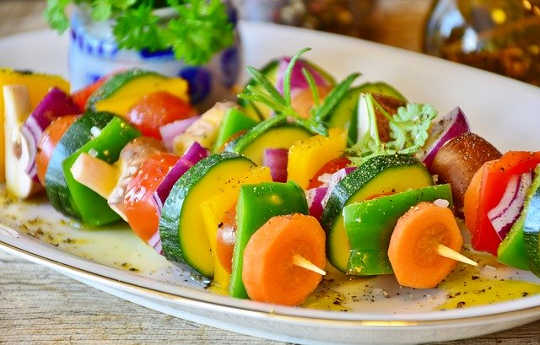
Image by RitaE
Americans seem constantly to be on diets -- grapefruit diets, cabbage diets, low-carb diets, high-protein diets, raw food diets, you name it. The elusive goal of these many plans is weight loss. Yet we have the fattest society ever.
Forget these crazy schemes.
The original Greek word for diet was diaita, meaning a "way of life." That is a perfect description of the Color Code eating plan. It's a way of life that revels in the glorious spectrum of color that nature has provided us in foods. It's also a way of life that confers innumerable health benefits.
We will share with you our easy plan to build colorful fruits and vegetables into your diet. You'll be glad to know that you don't have to give up anything you love. There are no forbidden foods in the Color Code eating program. As we see it, the inevitable result of depriving people of tasty meals is merely to send them to the supermarket two weeks later in search of junk food. That's why there are no don'ts in this eating program. Only do's. But if you follow the guidelines, the good foods will gradually start to edge out the less healthful choices. Fruit snacks will replace donuts. Tea will oust sodas. Pretty soon, you'll be living a healthier life.
Mary Fleming, a dietician in Maine who works with Dan Nadeau, has seen extremely positive results when she put patients on the program. "It's an exciting and easy plan that makes healthy eating fun," she says.
GO FOR THE GOLD
The starting point of this eating plan is a simple color scoring system. There are no cumbersome calorie counts here -- just an easy plan to make sure you're getting enough fruits and vegetables from the different color categories. Your goal here is to strive for a daily "color score" of 100 points. The most important way to earn these points is simply to eat fruits and vegetables, but there are easy ways to earn bonus points, too. We'll provide dozens of tips to help you. Ready?
Your Plan for Color Scoring
There is only one essential rule to remember: Eat 9 to 10 servings of fruits and vegetables a day. Points: 10 each.
"Wait a minute!" you say. "What about the Five a Day program? Aren't people supposed to eat five servings of fruits and vegetables a day?" Well, yes. But the USDA Food Guide Pyramid actually prescribes a total of five to nine servings a day -- that is, three to five servings of vegetables and an additional two to four of fruit. The greatest benefits are at the top end of that range. "Of course, we know that people should eat nine servings a day," admits Barbara Berry of the Produce for Better Health Foundation, which runs the Five a Day campaign, together with the National Cancer Institute. "But people aren't even eating five. You have to start somewhere."
Programs with serious health improvement goals have even more radical targets. The DASH diet, which aims to reduce high blood pressure, prescribes 10 servings of fruits and vegetables a day. The experimental cancer-prevention diet at the AMC Cancer Research Center in Denver calls for 10 to 16.
The Good News
Right now, you may be saying to yourself, "No way! I can't eat nine to ten servings a day of that stuff every day." But here's the good news. You're probably eating more than you realize already. It isn't really that hard if you keep these tips in mind:
* Remember that serving sizes aren't that big. Half a cup of chopped raw vegetables or fruit makes a serving. Half a cup may sound like a lot, but it isn't. That's about the amount that would fill half a baseball. And a baseball fills up quickly, when you're talking about water-laden fruit. For dried fruit, a serving size is even smaller -- a quarter cup, or the size of a small box of raisins. Here is a general guide to serving sizes for fruits:
- Large fruit (cantaloupe, pineapple): 1 slice
- Medium fruit (apple, orange, banana): 1 fruit
- Small fruit (plums, kiwis, clementines): 2 fruits
- Berries (blueberries, strawberries): 1 cup
- Dried fruit (dried apricots, figs): 1/4 cup
Similarly, vegetable sizes are not large. Half a cup of chopped vegetables makes a serving. The exception is leafy greens. Because they take up so much space, a serving size is a whole cup, chopped.
* Think in threes. Nine servings sounds much more manageable if you think of it as three groups of three -- three servings in the morning, three in the afternoon, and three at night. For example, to get to three servings in the morning, start with a glass of orange juice, and you've already knocked one off. Toss a handful of raisins into your cereal, and that's serving number two. A slice of melon on the side puts you up to three. That's three servings before you even walk out the door. Even Monopoly was never this easy! And once you start learning colorful new recipes for vegetable fajitas and stews, soups and salads, and fruit smoothies, you will quickly realize how many dishes count as two to three servings all by themselves.
* Remember that snacks count, too. When we were growing up, the experts discouraged snacking. Now you can relegate that old idea to the compost heap of history. The body and brain rely on glucose for fuel. By eating smaller meals and snacking a couple times a day, you can keep your body and brain amply and steadily supplied. If, on the other hand, you go for long periods without eating, you're encouraging your body to raid its stores of protein to make glucose. (Besides, as dieters know all too well, if you skip meals, your body tries to conserve calories by slowing down your metabolism!) So go ahead and munch on an apple, some carrot sticks, or a handful of dried apricots.
* Juices count also. Wash down lunch with a V8 or throw some carrots into the juicer, and you get credit for a serving of produce. Fully 90 percent of the antioxidants in fruits are in the juice. Be aware, though, that when you drink juice, you sacrifice the healthy fiber in the whole fruit, along with many of the beneficial phytonutrients in the skins. And you can quickly take in too many calories, simply because you can easily guzzle, say, two glasses of apple juice instead of munching a single apple. So choose your juices carefully -- avoid sugar-laced "fruit drinks" -- and don't rely on them to fill your quota.
Portion Distortion
In this land of plenty, it seems that the standard serving size is now extra large. "Foreigners coming to this country express amazement at the amount of food served up in American homes and eateries," says Melanie Polk, director of nutrition education at the American Institute for Cancer Research. The "small" popcorn buckets in movie theaters used to be called "regular" a generation ago. A small ice cream cone today is often two scoops -- a size that we used to call "double." Even the standard restaurant plate size has grown, says Polk -- from 10.5 inches in diameter to 12 inches today. Not surprisingly, our mental image of normal serving sizes has grown, too.
But while restaurant portions have mushroomed, the USDA's definition of a serving has not. The amount of food that the USDA considers a serving is much smaller than most Americans imagine. Some examples:
* A serving of meat is three ounces, or the size of a deck of cards.
* A serving of hard cheese is one ounce, or about the size of your thumb.
* A serving of grains is one ounce. But bagels, for example, often weigh three to five ounces. That means you can get three to five servings of grains in a single helping!
* A serving of spaghetti is a half cup of cooked pasta -- or 32 meager strands.
* A serving of French fries consists of just 10 fries!
"Patients tell me they couldn't possibly eat six to eleven servings of grains a day, as the USDA recommends," says dietician Elizabeth Ward of the American Dietetic Association. "I tell them, 'Oh, I bet you eat that much by two P.M.' "
Ward coined the term "portion distortion" to characterize this problem of perceptions. The good news is that portions of fruits and vegetables are also much smaller than you expect. Just six spears of asparagus make a half-cup serving of vegetables. Eight medium strawberries count as a serving of fruit. Given the hefty amounts of vitamin C, folate, and dietary fiber in those few berries -- and a mere 45 calories -- that's not a bad deal!
Drink to Your Health
Man, as they say, does not live by bread alone. Drinks are essential, too. But which ones? John Weisburger of the American Health Foundation has devised a "fluids pyramid" resembling the USDA's food pyramid. At the broad base is water, the most essential of fluids, which helps just about every health-preserving process in the body. "Water is more essential than food," says Weisburger. "Every enzyme in the body works in a solution of water." He recommends at least four 8-ounce glasses a day.
In the middle tier of the pyramid, at five to eight 4-ounce servings a day, Weisburger places low-calorie or no-calorie liquids such as vegetable broth and tea. Drink brewed teas if you want the full benefits. "Even children can benefit from the antioxidants in tea," says Weisburger, "but they should stick with decaffeinated tea." On the next shelf up the pyramid -- at one to two glasses a day -- Weisburger places fruit and vegetable juices, such as orange juice and V8. They deliver all the great health benefits we've discussed in this book, but because they also have plenty of calories, you need to limit the proportion of your fluids that comes from juice. Soy milk and skim milk are also on this shelf of the pyramid. Note that some brands of soy milk are now fortified with calcium and vitamin D, for those who cannot digest cow's milk.
At the very top of the pyramid -- the part labeled "Use Sparingly" -- is red wine. Sure, it benefits the heart, but experts recommend no more than one glass a day for women and a maximum of two for men, or else any potential benefits will quickly dissipate.
Scoring Bonus Points
If you're an exceptionally good eater, you can get to your daily "color" goal of 100 points by eating ten servings of fruits and vegetables. But if you can't manage that many, don't despair. There are bonus strategies to help nudge you toward the top. If you're already at the top, you can use the bonus points to reward yourself with "extra credit." Here are our additional strategies:
* Choose fruits and vegetables from the Color Code Top Ten lists (see below). Bonus points: 5 each. Wait, don't panic! We're not asking you to eat more fruits and vegetables than you've eaten already. You've already collected 10 points for each serving. Now go back and see if any of them are on these Top Ten lists. For each one that is, collect an additional 5 points.
* Cover all four color groups in a day. Bonus points: 5. Again, this doesn't refer to eating more; it just rewards you for consuming a variety of foods. Variety is really the key to a healthy eating program. Blueberries are great. But if you eat only blueberries, you'll miss out on the ellagic acid in strawberries. Focus on strawberries, and you'll miss the limonene in oranges. Bank on oranges, and you've neglected the quercetin in apples or the resveratrol in grapes. You don't need to get hung up on all the phytochemical names -- just go for the whole color spectrum every day.
* Drink tea. Bonus points: 5 for two cups. Brewed tea delivers more points than most fruits and vegetables. Research indicates that its potent antioxidants make this beverage a super heart protector.
* Eat a fruit or vegetable you haven't eaten in the last year. Bonus points: 5. Often our tastes are formulated as children. Even as adults, we don't necessarily give "yucky" vegetables a second chance. That's too bad. What if Grandma overcooked the Brussels sprouts when you were a kid, or your mother never seasoned those frozen veggies? You might be missing out on vegetables you would actually love today. Brussels sprouts can be delicious if cooked to crisp-tender or soaked first in a subtle marinade. Try them again. Or sample a completely new food, like passion fruit, that wasn't widely available when you were younger. Any way you slice it, the broader your fruit-and-vegetable "repertoire," the more phytochemical protection you get.
THE COLOR CODE TOP TEN LISTS
We've never met a fruit or vegetable we didn't like, but some deliver more nutritional punch than others. Here are our top ten picks for fruits and vegetables that promote health. They include high-antioxidant foods, proven disease fighters, and foods from every color group.
FRUITS |
(Color) |
VEGETABLES |
Red: |
||
| 1. Strawberries | 1. Tomatoes | |
| 2. Raspberries | 2. Red bell peppers | |
Orange-Yellow |
||
| 3. Oranges | 3. Carrots | |
| 4. Mangoes | 4. Sweet potatoes | |
| 5. Grapefruit | 5. Winter squash | |
Green: |
||
| 6. Kiwi | 6. Kale | |
| 7. Avocado | 7. Broccoli | |
| 8. Spinach | ||
Blue-Purple: |
||
| 8. Blueberries | 9. Purple cabbage | |
| 9. Concord grapes | 10. Eggplant | |
| 10. Dried Plums |
Now Here's The Real Bonus
In addition to fighting aging, readers who follow the Color Code eating plan can lose weight and trim fat. The plan isn't a weight-loss program per se, but that's an inevitable outcome of replacing French fries and junk food with fresh fruits and vegetables. Gram for gram, produce has fewer calories and much less fat. Blueberries contain just 80 calories per cup. If you wanted to reach 2,000 calories by eating blueberries, you'd have to consume 25 cups! That means that if you eat mainly fruits, vegetables, and whole grains, you can eat a lot of food -- and actually lose weight! That won't happen, of course, if you only add a glass of juice and handful of raisins to a diet of Big Macs. But if you go all the way and actually shift to a semi-vegetarian diet, the challenge won't be cutting calories. It will be getting enough calories.
Eat More Colorful Foods
When it comes to food, let color be your guide, as you aim to make your meals more multi-hued than a Benetton ad. (No cheating by using artificially colored jelly beans or snack foods!)
Here are some suggestions to get you started:
* Look for recipes that combine at least two colorful foods, preferably from two different color groups. Look up unusual fruits and vegetables like starfruit or broccoli rabe on the Internet for great recipe ideas.
* Attend vegetarian cooking classes.
* When you're in the produce section of the supermarket, challenge yourself to find something appetizing from every color group. The Color Code Top Ten lists give you a good place to start.
* Buy a fruit or vegetable you've never eaten before. Then check the Internet for recipes or serving ideas.
* When you're cooking, see how many colors you can add to dishes. For example, there's no need for a salad to be plain green. Add carrots, red onions, purple cabbage, or any other colorful vegetable that appeals to you. And don't limit yourself to vegetables. Some salads are delicious with fruits, including mandarin oranges, strawberries, and even blueberries. Dried fruits, such as cranberries and raisins, also can be fabulous.
* Cook with colorful spices, such as turmeric and paprika.
* Use colorful garnishes, including parsley, chives, and cilantro. Color definitely adds to the visual appeal of a dish -- which in turn makes it even more appetizing. Watch cooking shows for ideas, and pay attention to the color on your plate when you dine out -- some chefs are very creative.
* Host a potluck dinner at your house and ask the guests to bring their most colorful recipes.
* Eat at ethnic restaurants to see how they prepare fruits and vegetables. One excellent option is a Mongolian barbecue, if there is one in your area. You start by filling your bowl at a salad bar with a wide range of colorful vegetables, plus noodles, chicken, and seafood. You then choose a mild or spicy sauce and the chef tosses everything onto a flat grill for flash cooking. At the end, you can add extra toppings, such as peanuts or fresh dill. Come back time and again to try different combinations of colorful vegetables and sauces.
* Make your snacks more colorful, too. Snacks are a terrific opportunity to abolish junk food and substitute healthful, colored foods, such as dried fruits or blueberry smoothies.
Your Kids Say "Not!"
Getting your children to eat right can be more frustrating than getting them to clean their rooms. One friend tells us that the only thing standing between her son and malnutrition is Sesame Street vitamins. If this sounds familiar, try these tips. It's never too early to start eating right. Most chronic diseases take decades to build up -- and the beginnings of atherosclerosis have been detected in children as young as eight and nine!
* Take the kids to a farmers' market and ask them to help select produce. It's hard to resist a barrel full of fresh peaches, corn, or vine-ripened tomatoes. The kids may even be tempted to eat some!
* Better yet, take them to a farm or orchard where they can pick their own fresh apples, strawberries, or blueberries.
* Be sneaky. The book Stealth Health by Evelyn Tribole is full of ways to disguise healthy ingredients in delicious dishes, right down to blending tofu into cheesecake.
* If the kids like frozen drinks, they'll love fruit smoothies. Make them with a variety of fresh fruits -- strawberries, bananas, peaches, and, of course, blueberries -- or buy frozen organic fruit without syrup. Let your kids help you make the smoothie; even very young children enjoy standing on a stool and dropping strawberries into the blender.
* Chop up fruit and leave it in the refrigerator for snacks in single-serving, reusable containers. Older kids or teens won't cut up cantaloupe on their own, but if it's already in chunks, they might grab it from the fridge.
* If oranges seem too hard for kids to peel, stock up on clementines and tangerines when they're in season. The skins peel off easily, and the fruits don't have a lot of bothersome seeds to irritate the kids.
* Serve dips. You'd be surprised how many vegetables will go down with a low-fat sauce, such as a yogurt-based dip.
* Add a spoonful of Parmesan cheese. "Kids are natural vegetable haters," says Elizabeth Ward of the American Dietetic Association. "But a little cheese on steamed cauliflower seems to take the edge off." Cheese is an intense source of calcium, and kids love it.
* Be creative. Vegetable plates can be laid out to look like people, teddy bears, or kittens. Use almonds for eyes, carrot curls for hair, and jicama slices for eyeglass arms. Make a bag of "coins" out of carrots and radishes. Fill a celery stick with peanut butter and top it with raisins to make "ants on a log." Create radish "roses" by making a series of vertical cuts around the outside.
* Play with your fruit, too. Nutritionist Melanie Polk of the American Institute for Cancer Research used to make "banana faces" for her daughter. "Start with banana slices to make the eyes, nose, teeth, mouth, and hair," says Polk.
Use raisins for the pupils or to fashion a raisin mustache. Peach slices can be ears. "To this day my daughter, who's in college, still asks for banana faces," she says.
* Plan "ethnic" food nights. Not only do kids learn about new foods and cuisines, but they can also have a lot of fun. Eat Chinese food with chopsticks. Dip pita bread into Turkish appetizers. Scoop up Ethiopian food in a flatbread called injera. In India, the traditional way of eating is ... with your fingers! To do it properly, have fingerbowls handy and do not get your fingers dirty above the second knuckle.
* And finally, set a good example. If you eat fruits and vegetables, your kids are more likely to do the same.
Reprinted with permission of the publisher,
Hyperion. ©2002. http://www.hyperionbooks.com
Article Source:
The Color Code: A Revolutionary Eating Plan For Optimum Health
by The Philip Lief Group, Inc.
 Color cures! That's the simple premise behind The Color Code. While we all know that healthy eating is the key to a long life, few people understand why the natural pigments that give fruits and vegetables their color can help protect your body, too. Combining their expertise in aging and nutrition, a leading scientist and an outstanding physician show readers how to prevent the most common age-related illnesses through a simple multicolored eating plan.
Color cures! That's the simple premise behind The Color Code. While we all know that healthy eating is the key to a long life, few people understand why the natural pigments that give fruits and vegetables their color can help protect your body, too. Combining their expertise in aging and nutrition, a leading scientist and an outstanding physician show readers how to prevent the most common age-related illnesses through a simple multicolored eating plan.
Click here for more info and/or to order this book.
About the Authors
 JAMES A. JOSEPH, PH.D., is lead scientist and lab chief of the Laboratory of Neuroscience of the USDA Human Nutrition Research Center on Aging at Tufts University. He has held positions at the National Institutes of Health, and has won several grants and awards in the area of gerontology. He lives in Plymouth, Massachusetts.
JAMES A. JOSEPH, PH.D., is lead scientist and lab chief of the Laboratory of Neuroscience of the USDA Human Nutrition Research Center on Aging at Tufts University. He has held positions at the National Institutes of Health, and has won several grants and awards in the area of gerontology. He lives in Plymouth, Massachusetts.
 DANIEL A. NADEAU, M.D., is clinical director of the Diabetes Center and Nutrition Support at the Eastern Maine Medical Center in Bangor and assistant professor at Tufts Medical School. He lives in Hampton, Maine.
DANIEL A. NADEAU, M.D., is clinical director of the Diabetes Center and Nutrition Support at the Eastern Maine Medical Center in Bangor and assistant professor at Tufts Medical School. He lives in Hampton, Maine.
ANNE UNDERWOOD is a reporter for Newsweek, where she has been writing about health and medicine issues for seventeen years. She lives in Hoboken, New Jersey.

























